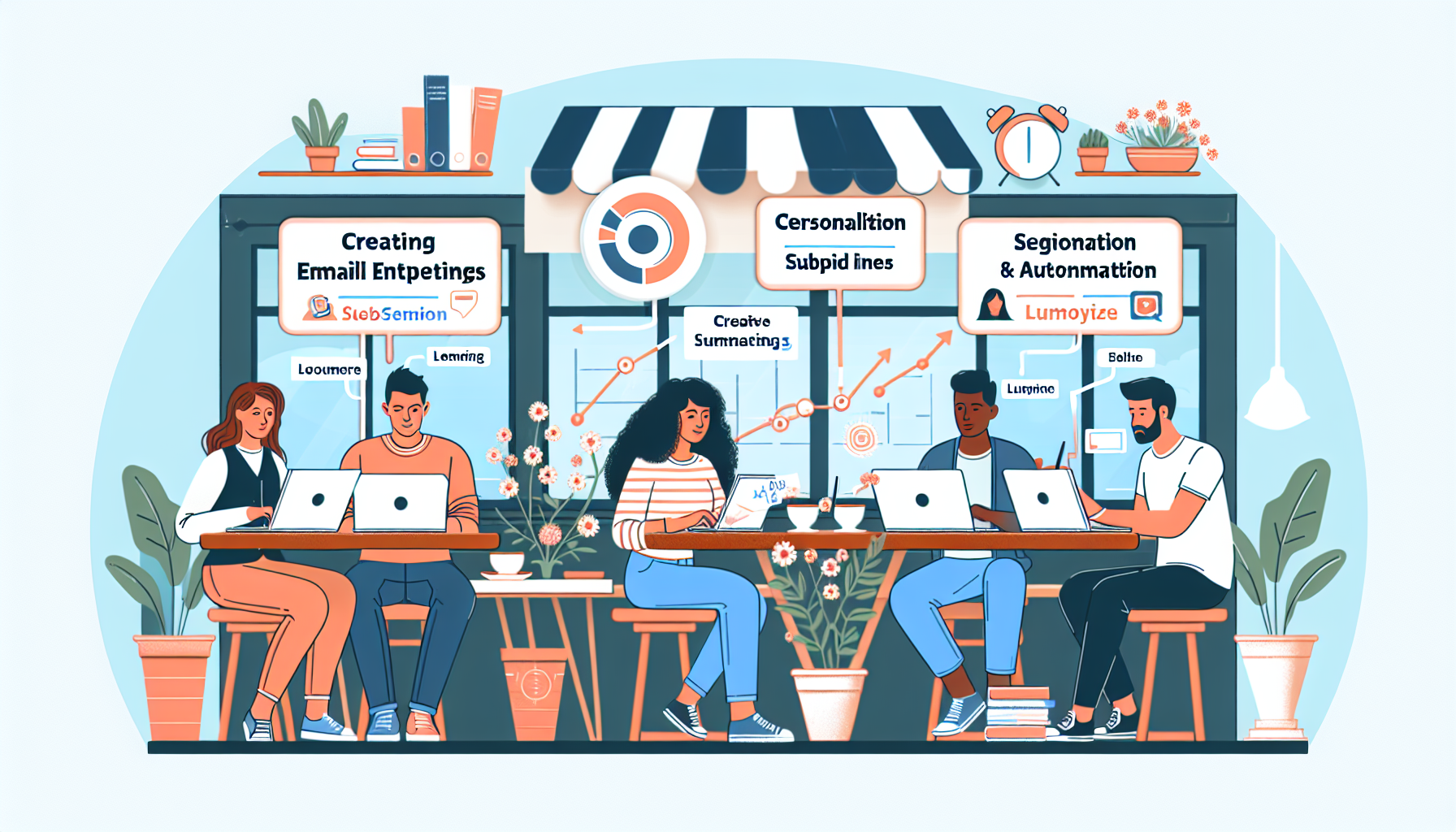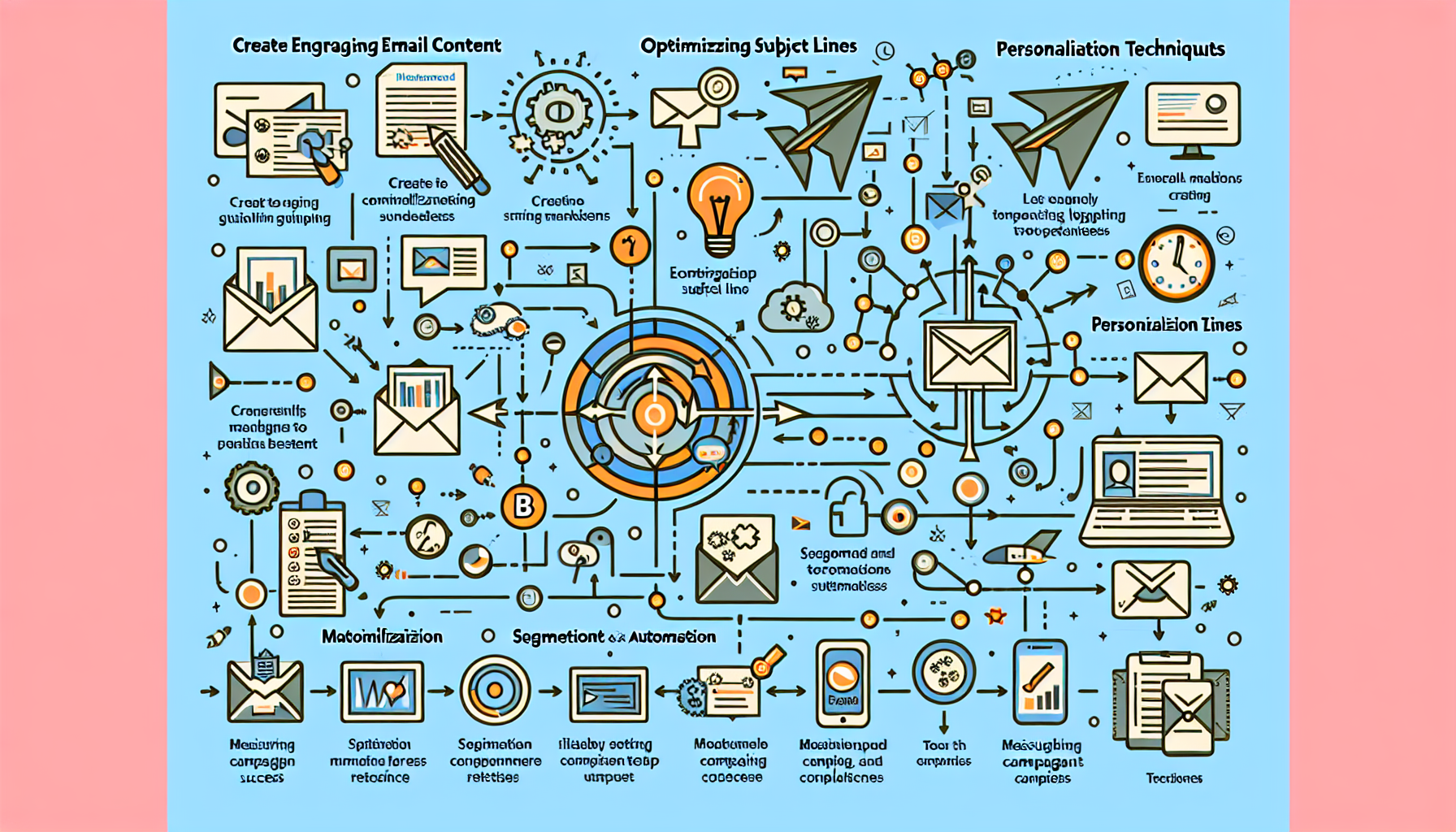Are you a small business owner looking to enhance your marketing efforts? Look no further, as we have compiled 10 effective email marketing strategies tailored specifically for small businesses. In today’s digital world, email marketing continues to be a powerful and cost-effective tool to reach your target audience, build customer relationships, and drive sales. From crafting compelling subject lines to personalizing your content, these strategies will help you maximize the impact of your email campaigns and achieve tangible results for your business. So, let’s dive in and discover the secrets to successful email marketing for small businesses.

Segment your audience
Demographic segmentation
Segmenting your audience based on demographics such as age, gender, location, and occupation allows you to tailor your email marketing campaigns to specific groups. By understanding their characteristics and preferences, you can create content that resonates with each segment, increasing engagement and conversions.
Behavioral segmentation
Behavioral segmentation involves dividing your audience based on their actions, interactions, and engagement with your brand. By analyzing their past purchases, website browsing behavior, and engagement with your emails, you can send targeted emails that cater to their interests and preferences, leading to higher open and click-through rates.
Psychographic segmentation
Psychographic segmentation involves understanding the psychological and lifestyle characteristics of your audience. By analyzing their values, beliefs, interests, and attitudes, you can create emails that resonate with their motivations and aspirations. This allows you to foster a deeper connection with your audience, leading to increased loyalty and advocacy.
Build a quality email list
Opt-in forms on your website
Create opt-in forms on your website to encourage visitors to subscribe to your email list. Place these forms strategically on high-traffic pages and offer an incentive, such as a discount or exclusive content, in exchange for their email address. Make the forms easy to fill out and ensure that you clearly communicate the value they will receive by subscribing.
Lead generation campaigns
Run lead generation campaigns to attract potential customers and collect their email addresses. Offer valuable content, such as e-books, webinars, or free trials, and require users to provide their email address to access it. This not only helps you build your email list but also positions your brand as a trusted authority in your industry.
Social media lead generation
Leverage social media platforms to generate leads and grow your email list. Encourage your followers to sign up for your emails by promoting exclusive offers, sharing teaser content, or conducting giveaways. Include links to your opt-in forms in your social media bios and posts to make it easy for people to subscribe.
Email list cleaning
Regularly clean your email list to maintain its quality and effectiveness. Remove inactive subscribers, verify email addresses, and update contact information. This ensures that your emails are delivered to engaged and interested recipients, improving open and click-through rates.
Craft compelling subject lines
Use personalization
Personalize your subject lines by including the recipient’s name or other relevant details. This catches their attention and makes the email feel more tailored to their needs. Personalization shows that you value your subscribers and increases the likelihood of them opening your emails.
Create a sense of urgency
Incorporate words and phrases that create a sense of urgency in your subject lines. This motivates your subscribers to take immediate action and increases the chances of them opening your emails. Words like “limited time only,” “exclusive offer,” or “don’t miss out” can create a sense of urgency and intrigue.
Ask intriguing questions
Pose thought-provoking questions in your subject lines to pique your subscribers’ curiosity and encourage them to open your emails. Questions like “Want to boost your productivity in 5 easy steps?” or “Are you making these common skincare mistakes?” make readers want to find out the answers, leading to higher open rates.
Include numbers or statistics
Numbers and statistics in subject lines make your emails more specific and tangible. Instead of saying “Ways to improve your SEO,” say “7 Proven SEO Strategies for Ranking Higher.” The use of numbers adds credibility and gives subscribers a clear idea of what they can expect from your email.
Design visually appealing emails
Choose a clean layout
Opt for a clean and organized email layout that is easy to read and navigate. Use headings, subheadings, and bullet points to break up text, making it scannable. Avoid cluttered designs or excessive use of images and ensure that your email is visually appealing across different devices and email clients.
Use eye-catching fonts and colors
Choose fonts and colors that are visually appealing and align with your brand identity. Use contrasting colors for text and background to ensure readability. Experiment with bold and italicized fonts to highlight important information and draw attention to key elements in your emails.
Include images and videos
Incorporate visually engaging images and videos in your emails to capture attention and convey your message effectively. Use high-quality visuals that are relevant to your content and products/services. Incorporate video content to showcase product demonstrations, customer testimonials, or behind-the-scenes footage.
Optimize for mobile devices
Optimize your email design for mobile devices as a significant percentage of users open emails on their smartphones. Ensure that your emails are mobile-responsive, with text and images adapting to different screen sizes. Use concise and compelling content that is easy to read and interact with on mobile devices.

Personalize your emails
Address recipients by name
Addressing recipients by their name creates a personalized and friendly tone. Use email marketing software that allows you to automatically insert the recipient’s name in the email content. This small gesture adds a personal touch and makes your subscribers feel valued.
Use dynamic content
Utilize dynamic content that adapts based on the recipient’s preferences or past interactions with your brand. This allows you to deliver tailored messages and recommendations, increasing engagement and conversion rates. Personalized recommendations, product suggestions, or personalized offers can significantly enhance the effectiveness of your emails.
Segmentation-based personalization
Take advantage of your audience segmentation by creating email content specifically for each segment. Tailor your content to address their unique needs, pain points, and interests. By sending targeted emails, you demonstrate that you understand and care about their individual preferences, enhancing the relevance and effectiveness of your email marketing campaigns.
Provide valuable content
Educational content
Offer educational content that provides value to your subscribers. Share industry insights, tips and tricks, how-to guides, or informative blog posts that help them solve problems or achieve their goals. Position yourself as a trusted source of information, establishing credibility and fostering engagement with your email subscribers.
Exclusive offers and discounts
Reward your email subscribers with exclusive offers and discounts. Provide them with access to limited-time promotions, early bird discounts, or special deals. By offering exclusive perks, you create a sense of importance and appreciation, encouraging your subscribers to stay engaged and make purchases.
Customer success stories
Share customer success stories and testimonials in your emails. Highlight how your product or service has positively impacted your customers’ lives or businesses. This builds trust and social proof, as prospective customers can see the real-world benefits of choosing your brand.
Relevant industry news
Keep your subscribers informed about the latest news and developments in your industry. Share industry trends, research findings, or regulatory updates that are relevant to your audience. Position yourself as an industry expert and a valuable source of information, further solidifying your relationship with your subscribers.
Include clear call-to-actions
Use persuasive language
Craft compelling call-to-action (CTA) copy that clearly communicates the benefit or action your subscribers should take. Use action verbs and persuasive language to motivate them to click on your CTAs. For example, instead of “Learn More,” use “Discover the Secrets” or “Unlock Your Potential.
Highlight benefits
Focus on the benefits your subscribers will gain by clicking on your CTAs. Clearly communicate the value they will receive or the problem they will solve. By highlighting the benefits, you appeal to their needs and desires, making your CTAs more enticing.
Create a sense of urgency
Incorporate a sense of urgency in your CTAs to create a fear of missing out (FOMO). Use phrases like “Limited-time offer,” “Only X spots available,” or “Act now” to instill a sense of urgency and prompt immediate action.
Use buttons instead of plain text links
Make your CTAs more noticeable by using buttons instead of plain text links. Design these buttons with contrasting colors, clear and concise text, and ample whitespace around them. This draws attention to your CTAs and makes them more clickable.
Automate your email campaigns
Welcome emails
Send automated welcome emails to new subscribers to thank them for joining your email list. Introduce your brand, provide a brief overview of the value they can expect, and offer a special welcome gift or discount. Welcome emails establish a positive first impression and set the stage for further engagement.
Abandoned cart emails
Automate abandoned cart emails to recover potential lost sales. When a user adds items to their cart but doesn’t complete the purchase, send a series of reminder emails. Include personalized product recommendations, discounts, and clear CTAs to encourage them to go back and complete the purchase.
Birthday or anniversary emails
Send automated birthday or anniversary emails to show your subscribers that you value them. Offer special discounts, gifts, or exclusive content as a token of appreciation for their loyalty. These personalized emails help strengthen the relationship with your subscribers and increase brand affinity.
Drip campaigns
Implement drip campaigns to nurture your leads and guide them through the customer journey. Create a series of automated emails that are triggered by specific actions or time intervals. Each email in the series delivers relevant content, educates the subscriber, and encourages them to take the next step towards making a purchase.
Measure and analyze your results
Open rates
Track your email open rates to gauge the effectiveness of your subject lines and overall email deliverability. A high open rate indicates that your subject lines are compelling and that your emails are successfully reaching the intended recipients’ inboxes.
Click-through rates
Measure your click-through rates to assess the performance of your CTAs and the engagement level of your audience. A higher click-through rate indicates that your emails are successfully driving recipients to take action and interact with your content.
Conversion rates
Analyze your conversion rates to determine the success of your email campaigns in terms of generating sales or desired actions. This metric helps you understand the effectiveness of your email content and CTAs in converting subscribers into customers or leads.
Subscriber growth
Track the growth of your email list to understand the impact of your lead generation efforts. A steady increase in subscribers indicates that your email marketing strategies are attracting new potential customers and expanding your reach.
Test and optimize your campaigns
A/B testing subject lines
Run A/B tests to compare the performance of different subject lines. Divide your email list into two groups, and send each group the same email with different subject lines. Analyze the open rates to determine which subject line resonates better with your audience and optimize future campaigns accordingly.
Testing different email designs
Experiment with different email designs to identify the layout, color schemes, and visual elements that generate the highest engagement. Test variations of your emails with different segments of your audience and track metrics such as click-through rates and conversion rates to optimize your designs.
Testing call-to-action placement
Test different placements and styles of your CTAs within your emails. Vary the position, color, text, and design of your CTAs and analyze their performance. This allows you to find the optimal placement that maximizes click-through rates and conversions.
By implementing these email marketing strategies, you can effectively engage your audience, drive conversions, and boost the success of your small business. Remember to continuously analyze your results, test different approaches, and optimize your campaigns to better meet the needs and preferences of your subscribers. Happy emailing!











